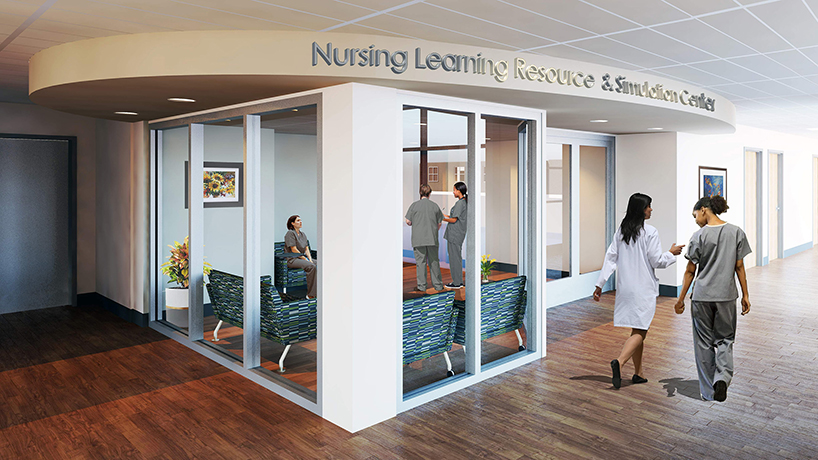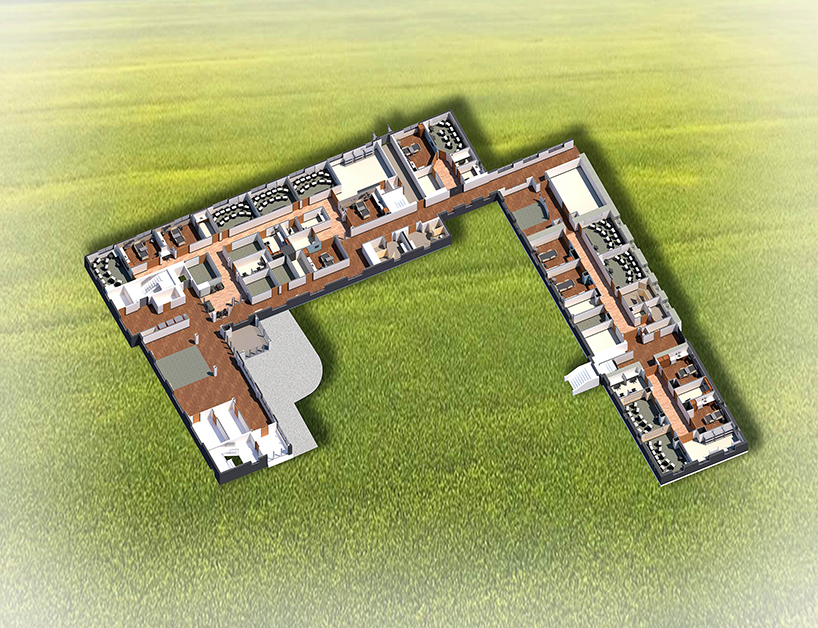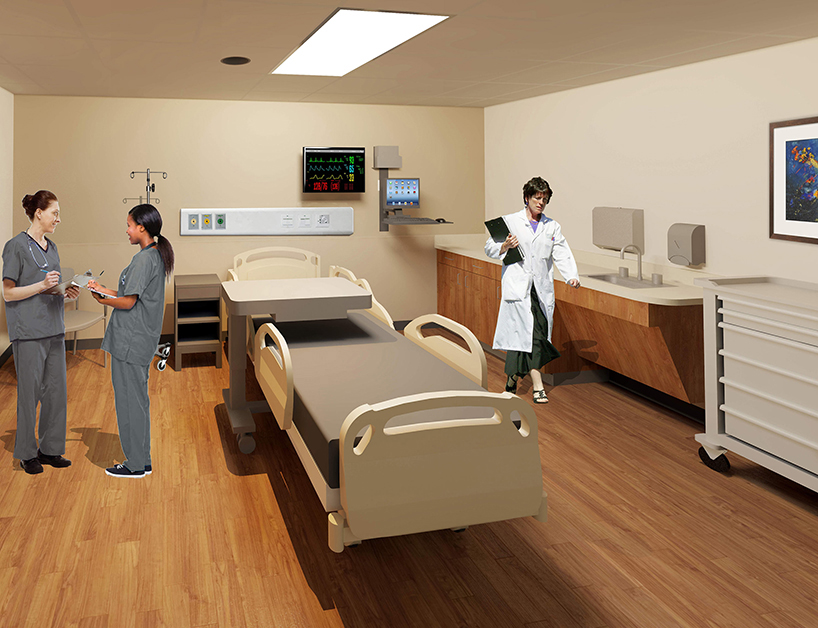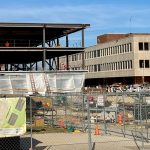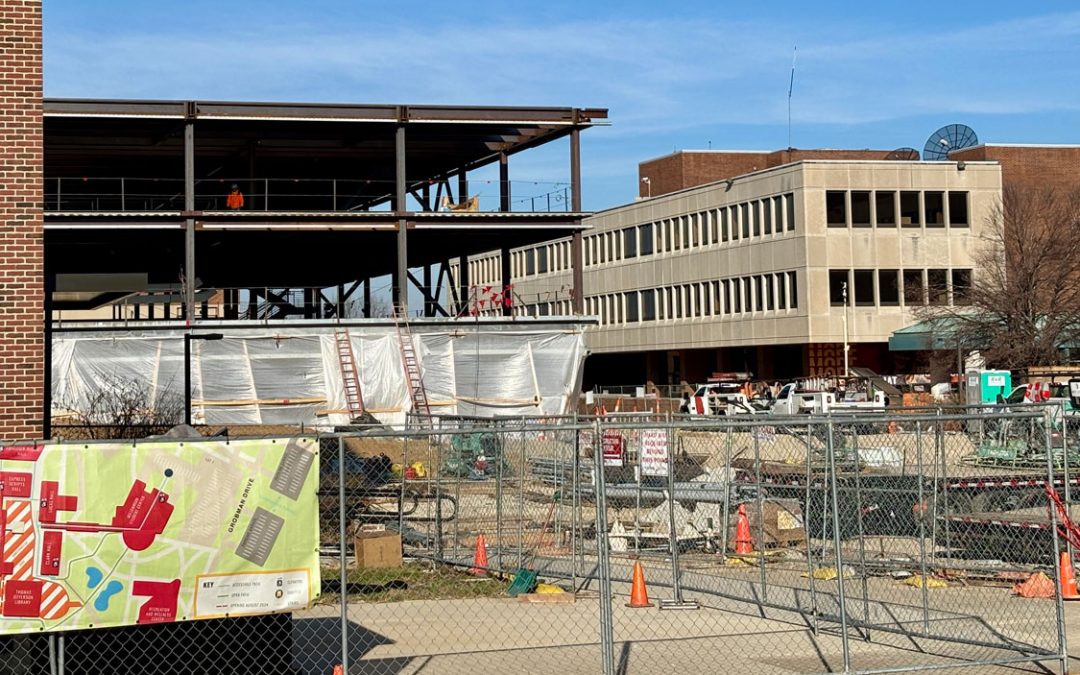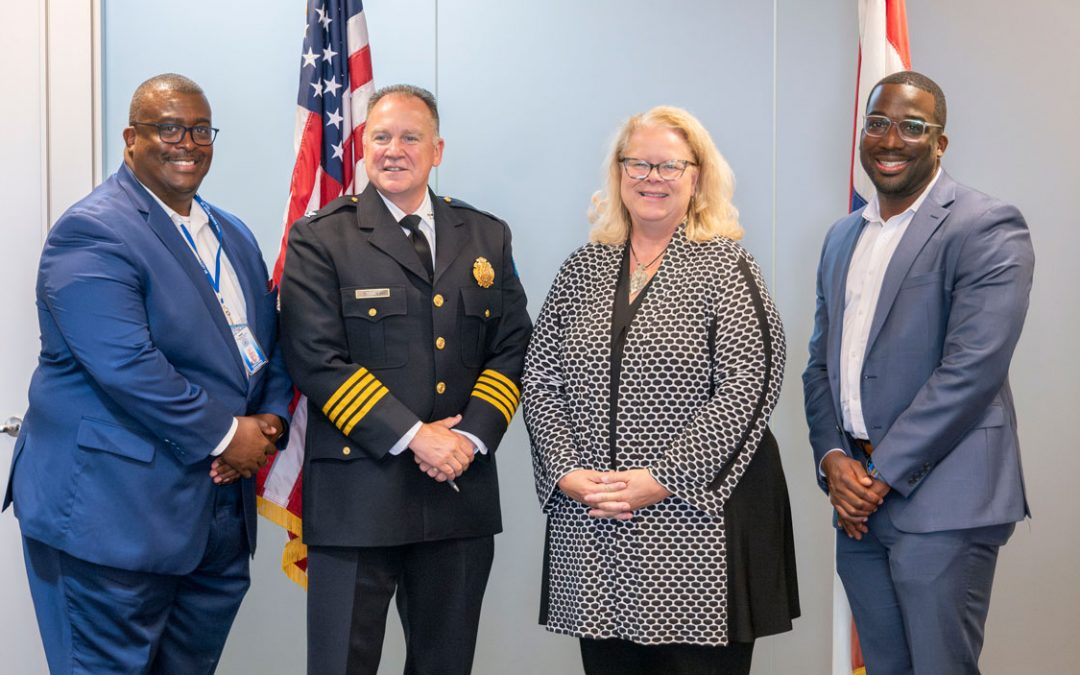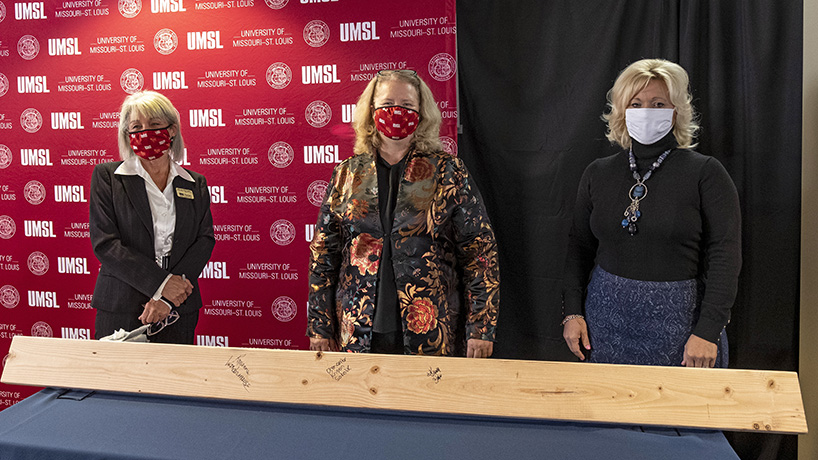
From left: Roxanne Vandermause, interim dean of the College of Nursing; Chancellor Kristin Sobolik; and Kristine Ziegler, vice president of Strategy and Clinical Program Development at Centene Corporation and campaign committee chair spoke to UMSL’s commitment to preparing nurses to ensure the health and well-being of the St. Louis region and beyond at today’s Nursing Learning Resource and Simulation Center construction kickoff. Attendees signed a beam that will be used in the construction of the space. (Photo by August Jennewein)
With the nursing vacancy rate at 10.4 percent in St. Louis region hospitals and expected to grow, nursing education had never been more critical.
The COVID-19 pandemic has further exposed the dire shortage while adding to the already heavy burden on existing health professionals.
As one of the largest educational institutions for nurses in St. Louis and Missouri, the College of Nursing at the University of Missouri–St. Louis is driven to help address the nursing vacancy gap and ensure the stability and growth of health care in the region. Today, the university took a large step toward that goal when it kicked off construction on Phase 1 of the renovation and expansion of its Nursing Learning Resource and Simulation Center during a hybrid in-person and virtual event at 10 a.m. in the lobby of Seton Center Hall on UMSL’s South Campus.
“This moment, more than any other in our recent history, has illustrated the critical need to invest in educating and preparing skilled nurses who impact the health, safety and wellbeing of our communities and region,” Chancellor Kristin Sobolik said. “The global pandemic we are all facing has changed each of our lives. Everyone in this room, and those joining us online, has engaged with a nurse at some point in their lives, and we all understand how important it is to have access to well-educated nurses.
“The University of Missouri–St. Louis is committed to improving health resources throughout the St. Louis region and beyond. Today, we take a large step forward.”
The speakers included Sobolik; Roxanne Vandermause, interim dean of the College of Nursing; and Kristine Ziegler, vice president of Strategy and Clinical Program Development at Centene Corporation and campaign committee chair. After the remarks, the attendees signed a construction beam and toured the facilities.
- The 21,000-square-foot immersive learning center will provide state-of-the-art space, equipment and technology to train the next generation of nurses.
Designed by the St. Louis firm Archimages, the 21,000-square-foot immersive learning center will provide state-of-the-art space, equipment and technology to train the next generation of nurses. The new facility will increase the number of simulation rooms from five to eleven, allowing the college to grow the number of pre-licensure BSN students it graduates by 20 percent annually. That means more nurses nationally and in the St. Louis region, as 90 percent of UMSL nursing graduates remain in the area to live and work.
The project is expected to cost a total of approximately $7 million, for both construction and equipment costs. Phase 1 will be completed in summer 2021 and include a 5,000-square foot expansion of the simulation labs and a renovation of the existing skills lab in Seton Center Hall. UMSL has raised $1.5 million toward this phase with support from donors such as Mercy Hospital St. Louis, Enterprise Holdings Foundation, the Hearst Foundations, Mary E. Walker, Nancy and Don Ross, and Terry and Stan Freerks.
“As a health care executive and nurse, I see firsthand how rapidly health care is changing,” Ziegler said. “Nurses today must be constant learners, adapting to new technology, bridging cultural differences, adopting new standards of care, and especially today, delivering care in challenging circumstances. This new facility will be transformative for the education of the nurses to join the health care workforce.”
Nursing simulation is an increasingly essential component of nursing education and offers an effective and efficient use of the limited faculty and clinical placement resources in the nursing field. More than a substitute for in-person clinical experiences, simulation broadens student competencies as they perform duties that only licensed RNs can perform in the real world and experience high-risk situations infrequent in daily practice.
Simulation labs have been especially critical during the pandemic as the college’s clinical partners have often been overburdened. Throughout the spring semester, nursing students were unable to engage in traditional clinical experiences due to restrictions brought about by the pandemic.
“Our entire college of nursing faculty and staff really have come together to think through what we need to do to incorporate the best simulation teaching skills we can deliver for our students,” Vandermause said. “Simulation complements clinical practice in actual health care settings, like hospitals and clinics and community settings, making simulation plus clinical practice the gold standard of nursing education. This new lab will allow us to prepare students for a variety of settings and scenarios, some that we could not otherwise provide for students directly.”
UMSL nursing graduates are equipped with the skills, knowledge and compassion needed to provide the highest levels of health care. UMSL educates more than 1,000 nursing students each year, the majority of whom are from Missouri. The College of Nursing offers bachelor’s and doctoral – PhD and DNP – degrees in nursing. Over 40 percent of UMSL nursing students are first-generation college students, 34 percent are from minority populations and 45 percent are Pell-Grant eligible.
UMSL nursing graduate programs are in the top 80 in the 2021 U.S. News and World Report rankings. The RN to BSN program is ranked No. 15 on the Best Value College rankings and the DNP program ranked as the top online program in Missouri and among the top 25 percent of online programs nationally. Placement rates for graduates consistently range between 95 to 100 percent, and the first-time success rate on the NCLEX-RN exam in calendar year 2019 was 87.4 percent.
Artist renderings:
- Nursing Simulation Center Layout
- Nursing Simulation Center Layout
- Nursing Simulation Center
- Nursing Simulation Center Layout
Media coverage
St. Louis Post-Dispatch
St. Louis Public Radio | 90.7 KWMU
S. Louis Business Journal
KMOV
Fox 2 Now
KSDK

